Stuck in a Time Loop

A lighthearted comedy called Groundhog Day hit the silver screen in 1993, the year after Doug Evans became District Attorney of Mississippi’s Fifth Circuit Court District. The movie did reasonably well at the box office but nobody expected it to become a classic.
The plot was silly. Phil Connors (played by Bill Murray) is a weatherman sent to Punxsutawney, Pennsylvania to cover the annual Groundhog Day festival. Phil thinks the assignment is beneath his dignity and produces his halfhearted report as quickly as possible so he can get out of Punxsutawney as quickly as possible. A freak snowstorm forces him to spend the night and, when he wakes up to Sonny and Cher singing I Got You, Babe on his clock radio, he discovers that it is still Groundhog Day and he will have to produce his report yet again. Connors is caught in a time loop that just keeps going, for months, years, maybe even decades. Every morning its I Got You, Babe and the whole scenario plays out again.
This fluffy comedy became a classic because it packs a subtle moral message. Phil Connors can’t break the spell and end the time loop until he learns to do the right thing for the right reason. He had to move from cynicism to kindness; from selfish isolation to a love of community.

It all began one sleepy morning in July of 1996 when four people were mercilessly gunned down in Winona’s Tardy furniture store. Bertha Tardy, the store owner, Carmen Rigby, the business manager and Bobo Stewart and Robert Golden, two recent hires, were all killed execution-style, with a bullet to the back of the head.
Curtis Flowers was identified as the chief suspect short hours after the bodies were discovered. Defense attorneys have come and gone but Doug Evans has always been the prosecutor. He was forty-three when this ordeal began; now he’s sixty-six.
Why can’t Evans get a final conviction? If Flowers is tried by two or more black jurors, Evans gets a hung jury. When Evans has one or fewer black jurors to contend with, he gets a conviction but loses on appeal due to prosecutorial misconduct, typically being too obvious about keeping black people off the jury.
But the only punishment Doug Evans ever received for his shabby ways was a Groundhog Day restart. Déjà vu all over again, and again, and again.
And it wasn’t just the DA; the families of the four victims and Mr. Flowers, the town of Winona and the whole state of Mississippi have been forced to relive this nightmare that refuses to end.
Trial six was different. Evans got a jury of eleven whites and a single black man with few ties to Winona’s African American community. The jury convicted after 29 minutes of deliberation and the Mississippi Supreme Court, by a five-to-four margin, upheld the conviction.
Groundhog Day was over!
Except that it wasn’t. If the evidence against Curtis Flowers had been rock solid, the composition of the jury wouldn’t have mattered that much. Nobody, white or black, wastes any tears on a cold killer caught dead to rights.
My organization, Friends of Justice was asked to look into the Flowers case because Curtis Flowers wasn’t caught dead to rights. There was plenty of evidence, to be sure, but none of it, considered in isolation, stood up to scrutiny. The forensic experts called by the state relied on junk science. Eye witnesses either lacked credibility or appeared to be testifying under duress.
Lack of motive was the first big problem with this case. Curtis Flowers worked a few days at Tardy furniture two weeks before the murders before failing to show up for work following the 4th of July holiday. Of course he wasn’t re-hired, he clearly didn’t want the job all that badly.
The second big problem was a matter of logistics. How could a single shooter dispatch four people, one at a time, with no signs of flight or struggle?
The third big problem was psychological: Curtis Flowers didn’t fit the cold killer profile. Well known in Winona as an easy going gospel singer with no history of violence, Curtis Flowers was always an odd fit for this kind of crime. In 23 years of confinement, Flowers has never been disciplined by prison authorities.
Friends of Justice has been chronicling the weaknesses of the state’s case against Flowers for over a decade now. And we’re not alone. On appeal, the defendant’s crack defense team put together a damning critique of Doug Evans’ evidence and investigative methodology. And for the past two years, a team of investigators associated with the podcast In the Dark has been busily dissecting the case.
Here’s the significant thing. Friends of Justice, In the Dark and Flowers’ legal team all take different approaches, but our conclusions dovetail perfectly. Over the past year, one prosecution witness after another has either recanted trial testimony or admitted that they have no idea whether they saw Curtis Flowers on the day of the murders or not.
By the time the Flowers case was considered by the federal Supreme Court, the story had been featured in the New York Times, the Washington Post, The New Yorker, and every other media outlet you can name. Thanks largely to In the Dark, millions of Americans were intimately acquainted with the details of this case and the Supreme Court justices knew their ruling would be weighed by an informed audience.
It was obvious from both oral arguments and the July 21st ruling overturning the sixth trial conviction that the justices (with the egregious exceptions of Neil Gorsuch and Clarence Thomas) realized that there was more afoot in this case than racial bias in jury selection.
After an initial explosion of relief and joy, friends and supporters of Curtis Flowers realized that Groundhog Day was cranking up for a seventh iteration. The federal Supreme Court would send the case back to the Mississippi Supreme Court who would, in their own good time, send it back to the Fifth Circuit Court District, Doug Evan’s bailiwick.
And, you guessed it, it’s Groundhog Day all over again.
Except it won’t be. First, someone other than Doug Evans will have to try this case going forward because the Grenada DA is damaged goods.
And no one else wants to touch this case.
So this isn’t just another Groundhog Day. It’s like somebody hit the pause button on the movie. Curtis Flowers continues to languish in the unbelievable heat and humidity of Parchman prison where he will likely remain until late August. And, even after he’s transferred to a pretrial facility (most likely the Carroll Montgomery Correctional Facility just down the road from Winona) he will not be a free man.
After that, it’s anybody’s guess how long it will be before somebody hits “play”.
A question of motive
Millions of people are asking why Doug Evans never has to pay for his sins. How can he be rebuked for racist behavior over and over again and still get to try this case?
Most of Evans’ sins flowed from his unwarranted conviction that Curtis Flowers did the deed.
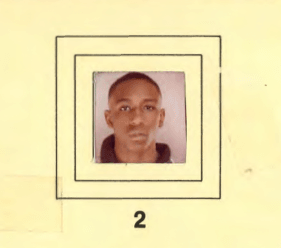
In the first week of the investigation at least four suspects were worthy of investigation. There was Marcus Presley, the Birmingham native who held up a string of small establishments in Birmingham in the days before and after the Winona murders. The sixteen year-old Presley was abetted by a second gunman, Lasamuel Gamble, and gradually escalated from threats of violence to murder. We know Presley was being considered as a suspect for the Winona murders because his picture showed up in a photo array used during the investigation.
And then there was Doyle Simpson, the semi-employed janitor at a nearby garment factory who reported his gun stolen the morning of the murders. Simpson had mob connections in New Orleans and initially lied about where he got his gun.
The third suspect was Willie James Hemphill, a Winona man with a serious drug problem and a history of violence. Hemphill was held for questioning for over a week shortly after the murders in Winona but released, he says, when his “airtight” alibi checked out. In the Dark recently discovered that Hemphill’s alibi (at the mall in Memphis with his girlfriend) might not be all that air tight after all.
None of these alternate suspects received serious consideration because Doug Evans, and his lead investigator, John Johnson, liked Curtis for the crime from the get-go. It probably came down to motive (Betha Tardy had refused to give Curtis his job back). A lame motive, for sure, but the other suspects seemed to have no motive at all.
Secondly, there was the fact that Curtis Flowers had no access to a vehicle in the days leading up to the murders. If he was the killer, therefore, he had to be on foot, and that meant all kinds of people could have seen him walking to the Angelica factory to steal Doyle Simpson’s gun, returning to his home, then lighting out for Tardy furniture, doing the deed and making his way home as second time.
All John Johnson had to do was badger and berate every living soul along these various routes and he was bound to turn up something. It took him almost a year, but he did.
This explains why Doyle Simpson, Marcus Presley, and Willie Hemphill were never seriously considered as suspects. They lacked a tangible connection to the Tardy furniture store, and they had wheels.
The echo chamber effect
So, why, considering the dearth of real evidence pointing to Curtis Flowers, were Evans, Johnson et al so convinced he was their man?
It’s called the “echo chamber effect”. Gradually, convenience hardens into conviction. Think of a sales meeting at the local Ford dealership where the guy who sold thirty units last month gets a plaque and makes a motivational speech. Then one guy after another reinforces the same theme. “Anybody can do this; you just have to work hard, work smart and believe in yourself. We can do this, people! Now get out there and sell.” That’s the echo-chamber effect in action.
Or, since we’re talking about Mississippi here, think of a testimony meeting. One person after another gets up and shares the wonderful change Jesus has wrought in their lives. The stories of transformation get more and more impressive. Everybody’s pumped. The Spirit is moving. Another example of the echo-chamber effect. The “Great Awakenings” that twice transformed the American frontier can’t be understood apart from this phenomenon.
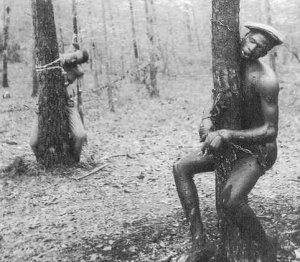
The perfect illustration of the echo chamber effect is a lynch mob. On April 13, 1937, two black men, Roosevelt Townes and “Bootjack” McDaniels were in the custody of the Montgomery County Sheriff in Winona, charged with shooting George Windham, a white merchant in the nearby community of Duck Hill. At the conclusion of a court hearing at which the two men entered pleas of not guilty, five hundred white men appeared outside the old courthouse. Sheriff’s deputies had their arms pinned behind their backs, the two defendants were bundled into a waiting school bus and driven to a field near Duck Hill.
Here’s a newswire report of what happened next (I am sparing you the most gruesome details:
After they were seized the mob tortured their victims by searing their flesh with blasts from gasoline blow torches. After thus brutally burning them, the wild mob piled brush high about them, saturated the brush with gasoline, and touched a match to the pyre.
When this brief summary of the event was read to the House of Representatives even Southern congressmen were horrified and the House passed America’s first anti-lynching law. Even the Nazi Reich in Germany condemned the deed. But the Senate version of the bill died a few weeks later, killed by a Southern filibuster. When Howard Kester did a follow-up visit to Duck Hill for the NAACP a few weeks later, he found that “of the scores of people with whom I talked not a single one greatly deplored the lynching. The citizens of Duck Hill seemed rather well pleased with themselves.”
That’s because they were still experiencing the echo chamber effect. The mob “knew” that Townes and McDaniels were guilty and the confidence of the mob transferred to every individual member.
Those who study wrongful convictions suggest that the same phenomenon is in play in cases where the crime is terrible, the evidence is ambiguous, and the pressure for resolution is overwhelming. The big fear for Evans and Johnson was that they wouldn’t be able to make a convincing case against anybody. For a man like Doug Evans, early in his career as a prosecutor, that sounded like a career killer.
And so, as Evans, Johnson and team talked up Flowers as a suspect they started liking him more and more. They had been raised in a culture that valorized the ability of white men to discern the guilt of black men apart from a careful consideration of the facts. The logic was straight out of Alice in Wonderland. First the verdict, then the trial. First we establish that Curtis did the deed. Then, because we know he is guilty, our investigation will inevitably support our verdict.
For a brief moment, Evans and Johnson thought Curtis might be their man; then they were pretty sure he was the guy; then, before a single eye witness was on record, they knew he was guilty, as sure as the lynch mob that murdered Townes and McDaniels in 1936 knew they were guilty.
When the echo chamber effect had run its course, Evans and Johnson regarded those who didn’t share their confidence as flat stupid.
Which explains why John Johnson didn’t mind scaring the hell out of potential witnesses; threatening jail time and family separation if they didn’t tell him what he wanted to hear. Since Curtis was guilty, any steps leading to a conviction were justified even if they included lies, threats and bribery. All for a good cause.
Blood on his hands
But for those who are convinced of Flowers’ innocence, Doug Evans comes off as villain worthy of Shakespeare.
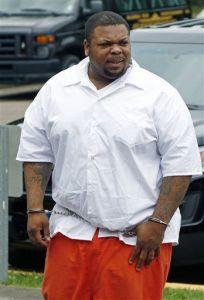
This is particularly true when you consider how Evans and star witness Cookie Hallmon have conducted a mutually satisfying affair of convenience since the early days of this saga. Hallmon is the brother of Patricia Hallmon, the woman who lived in the duplex next door to Curtis Flowers. (You can find the scoop on Patricia here. If you want the full lowdown on Cookie, check out Episode Five of In the Dark.)
Cookie Hallmon has been in and out of prison, before and after the murders at Tardy furniture, for drug crimes, assaults, DUI convictions and the like. But every time he ended up behind bars, Doug Evans slipped his star witness a get-out-of-jail-free card.
In a strange way, Cookie Hallmon is like Doug Evans: no matter how bad he messes up he has a tsunami of second chances. It didn’t matter if he was locked up or in the free world, Cookie could indulge his appetite for drugs, rape, assault and general mayhem without fear of consequences. Cookie had his own Groundhog Day going: no matter how grave his crimes he was soon back in the free world.
Ultimately, after the Mississippi Supreme Court upheld the 2010 conviction of Curtis Flowers, Doug Evans handed Cookie his walking papers for the last time. Back in the free world, Cookie started beefing with his relatives and ended up killing three people in two separate communities on one tragic night.
Some people, like Curtis Flowers, don’t belong in prison for a day, let alone twenty-three years. Others, like Cookie Hallmon, must be kept off the streets because they pose a persistent threat to public safety.
Let’s be blunt. Doug Evans used the most damaged human being in Winona, Mississippi to repeatedly convict one of the best souls the community has produced.
It doesn’t matter that Cookie Hallmon has now admitted that he concocted his testimony against Curtis in exchange for a get-out-of-jail-free card. The man should never have been believed in the first place.
The hands of Doug Evans are indelibly stained with the blood of three innocent people. The DA is like Lady McBeth—the “damned spot” won’t wash away.
A creature of his culture
But the man who has taken Curtis Flowers to trial six times shouldn’t be seen as an independent actor; Doug Evans is a creature of his culture.
Doug was two years old when the men who murdered Emmett Till were acquitted by an all-white jury in Sumner, Mississippi, just an hour away from Evan’s hometown.
Doug was eleven when the men charged with beating Fannie Lou Hamer and her friends half to death in the Winona County Jail were acquitted by an all-white jury.
In the Mississippi in which Doug Evans was raised, the primary purpose of the state criminal justice system maintaining the color line. By acquitting vicious brutes who were clearly guilty, the courts were telling the African American population that they had no right to equal justice. It was lynching by other means, a species of performative violence designed to reinforce the color line. There was nothing subtle about it. Nobody talked about these realities in public, but everyone, black and white, knew how the game was played.
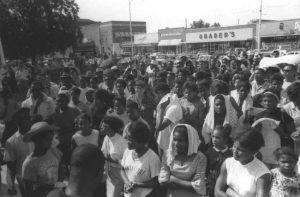
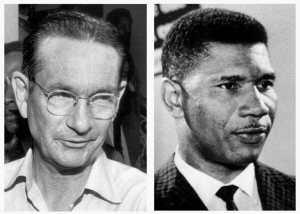
When Byron De La Beckwith went to trial for killing civil rights leader Medgar Evers in 1964, the results were slightly more encouraging. Beckwith wasn’t convicted, but he wasn’t acquitted either. Bill Waller, a young prosecutor who would eventually become the governor of the Magnolia State, knew he would wind up with an all-white jury, but he worked hard to eliminate the most dedicated bigots from the jury pool. This was difficult because agents with the pro-segregation Mississippi Sovereignty Commission, notorious for spying on civil rights activists, were actively gathering dirt on the handful of enlightened jurors who might cause trouble.
“Do you think it’s a crime to kill a nigger in the state of Mississippi?” Waller asked prospective jurors. The use of the racial slur was strategic. Precedent suggested that the answer was no; but everyone learned in school that the criminal justice system was supposed to be fair and equitable. The first time the question was asked, the potential juror sat in befuddled silence for what seemed an eternity. “He’s thinking it over,” Waller said with a chuckle.
Like most successful Mississippi politicians, Waller presented himself as a backwoods good ol’ boy. During the trial he even refused to address the victim’s widow as “Mrs. Evers” because that simple courtesy would have enflamed the courtroom and damaged his case. But Waller avoided an acquittal and, in Mississippi, that was as close to victory as he was going to get.
Three Kinds of Baptist
When Bill Waller was elevated to the Governor’s mansion, he refused to fund the Sovereignty Commission and appointed African Americans to important positions in his administration. Doubtless, Waller was motivated by his Baptist faith. The fact that Waller is a Baptist is completely unremarkable. Doug Evans is a Baptist too. So is Curtis Flowers. So were civil rights leaders like Fannie Lou Hamer and Martin Luther King Jr. Winona, Mississippi might be the most Baptist town in the most Baptist region of the most Baptist state in America.
But there are Baptists and there are Baptists. John Bunyan, the author of A Pilgrim’s Progress, pastored a “nonconformist” church in England, a crime for which he served twelve years in the Bedford prison (or gaol, as they say across the pond). He could have been released at any time had he pledged allegiance to the Church of England, but he refused. Bunyan can be categorized as a “Kingdom Baptist” because was willing to sacrifice his present comfort for the sake of a city not built by hand.
Like John Bunyan, Fannie Lou Hamer was a Kingdom Baptist. After being assaulted in the County Jail in Wynona, Hamer and her friends were released on condition that they plead guilty to disturbing the peace in open court. As Hamer entered the courtroom in Winona she cried out ““Do you people ever think or wonder how you’ll feel when the time comes you’ll have to meet God?” That’s how Kingdom Baptists talk.
You will not be surprised to learn that not all Baptists fit this pattern. In 1970, shortly before his death, John Lee Eighmy wrote Churches in Cultural Captivity, a seminal attempt to reckon with the origins of the Southern Baptist Convention. Southern Baptists, in Eighmy’s view, could imagine “social peace . . . only if the Negro ‘understands and cheerfully accepts’ a ‘subordinate place in society.” Let’s call these folks Culture Baptists
Doug Evans, his colorblind protestations notwithstanding, is a Culture Baptist. Given his childhood experience, this shouldn’t surprise us. White Baptists in the state of Mississippi do not rise to prominence by attacking the legacy and logic of white supremacy. The best they can do (to paraphrase Elijah the prophet) is to be Conflicted Baptists who “go limping between two different opinions”: white supremacy and equal justice.
Bill Waller Sr. ascended to the governor’s mansion in a day when it was still possible to win a statewide election with a combination of black and white votes. According to most political analysts, that is no longer possible.
Jim Hood, the current Mississippi Attorney General, may be an exception to that rule. The only Democrat still holding a statewide political office in Mississippi, Hunt appeals to white voters by saying nice things about God and guns, defending the death penalty, and strutting about like a tough-as-nails prosecutor. At the same time, Hood reads the parts of his Bible about caring for the poor and the oppressed. Hood is a Conflicted Baptist.
In his role as Attorney General, Jim Hood could end Winona’s Groundhog Day nightmare by taking the Curtis Flowers case out of Doug Evans’ hands. So far, he has refused. Unless Evans asks him to take over the Flowers case, Hood says, he isn’t going to intervene.
Hood’s dilemma is pure Mississippi. He knows that if he takes over the Flowers case he will be forced to drop the charges and give Curtis his freedom. That might be the right thing to do, but Hood can’t take this step without being condemned as a liberal by those who still expect the criminal justice system to reinforce white supremacy. Jim Hood is a Conflicted Baptist, limping between the claims of culture and the claims of God’s Kingdom; between the logic of white supremacy and the pursuit of equal justice under law.

In 2005, in his capacity as Attorney General, Hood helped convict Edgar Ray Killen, a Culture Baptist preacher implicated in the deaths of three civil rights workers in a case made famous by the 1988 movie Mississippi Burning. The official inquiry into the case was then quietly closed.
But Hood remains a Conflicted Baptist. Five years before the Killen verdict, Hood prosecuted 20 year-old Marlon Howell in the Mississippi Delta town of New Albany. The case against Howell has unraveled in recent years: Hood’s star witness is an ardent white supremacist and one of Howell’s friends who originally testified for the state has now recanted his testimony. But Hood defends the original conviction in terms that bear a haunting familiarity to the rhetoric of Doug Evans.
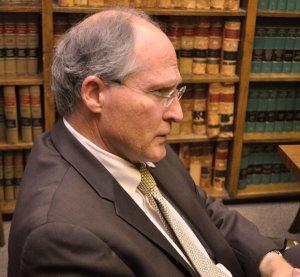
And then there is Bill Waller, Jr., the son of the man who once put Byron De La Beckwith on trial. Waller Jr. has spent the past 21 years on the Mississippi Supreme Court. In this capacity, he has voted to overturn the conviction of Curtis Flowers on three separate occasions; the most recent being in 2014. The first two times, Waller voted with the majority; in 2014 he sided with the minority.
Like Democrat Jim Hood, Bill Waller, Jr. is running for governor, only as a Republican. Waller entered the race late and may not have enough time to catch the Donald-Trump-loving front runner, but he’s giving it his best shot. Will Bill Waller inject his concerns about the Flowers case into the race? If he wins the Republican primary, he may (it would be a good way to win crossover votes). But thus far, Waller’s focusing on education, roads and infrastructure projects. Like Hood, Waller has little use for Donald Trump, but with the president’s popularity at 60% in Mississippi (likely over 85% among white voters), neither man wants to beef with the president.
Culture Baptists like Doug Evans are utterly predictable. They effect change only indirectly, by fighting for the status quo. Winona’s time loop is largely a product of Evans’ cultural captivity.
But Conflicted Baptists are like Forest Gump’s box of chocolates: you never know what you’re going to get. Jim Hood and Bill Waller Jr. just might sacrifice their political prospects for the sake of the Kingdom. If Waller realizes he can’t win the Republican nomination, he might just roll the Kingdom dice. Don’t hold your breath, but you never know.
At some point, somebody is going to drop the charges against Curtis Flowers. Doug Evans might kick the case over the Hood because the “liberal media” has made it impossible for him to do his job. Hood could step in and take the case out of Evans’ hands. If Mr. Flowers is released on bail, the pressure on the system will diminish dramatically, which is why it just might happen.
But Winona’s Groundhog Day won’t end until somebody does the right thing. And with the ghosts of Mississippi still roaming the corridors of power and the halls of justice, doing the right thing comes with a steep price.
